#The Grail
Text


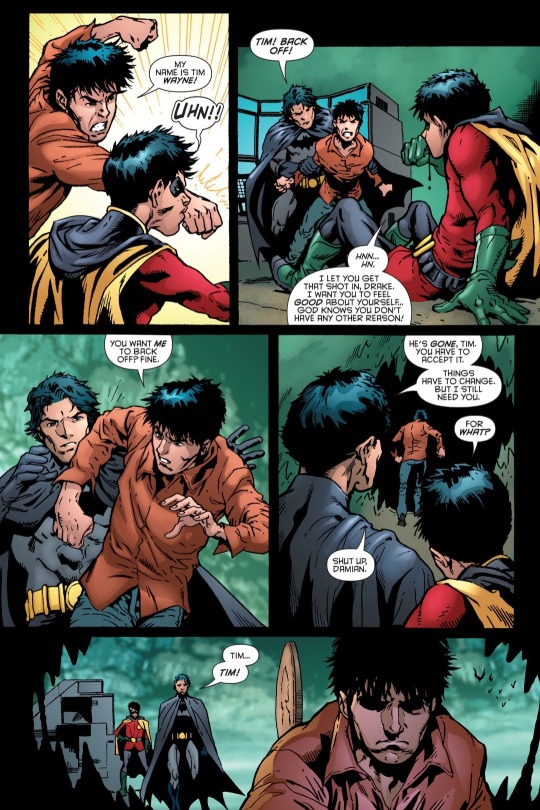

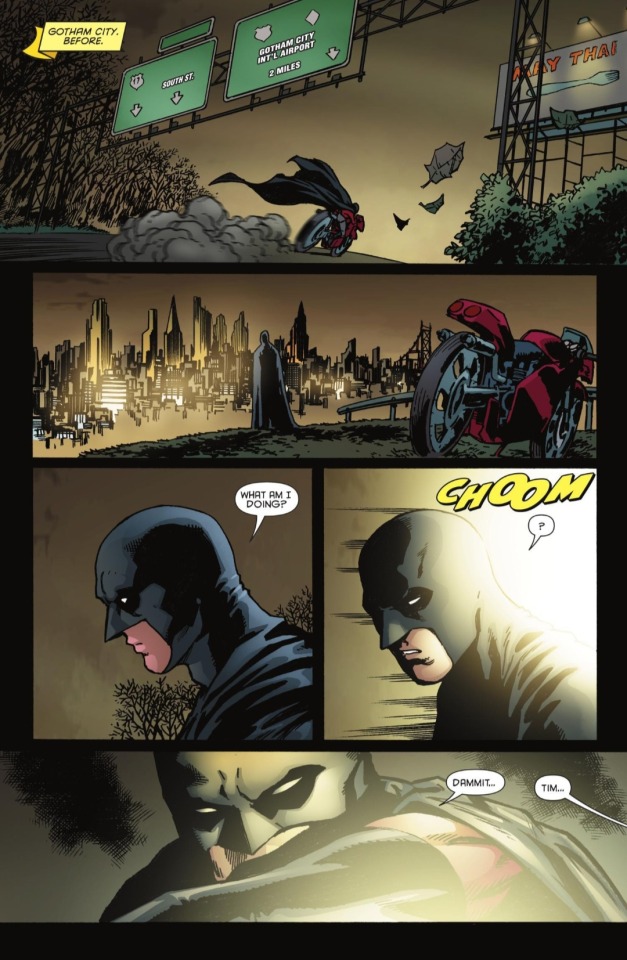





"I'm leaving, Dick. And I need you to let me go. You called us equals, remember? If we really are equals, if we really are brothers... Then believe in me. I've earned it. You take care of Gotham. Try not to let Damian destroy everything you and I built as Robin."
Red Robin. "The Grail."
#dc comics#batman#bruce wayne#dick grayson#tim drake#damian wayne#dc robin#red robin#robin tim drake#robin damian#batman dick grayson#the grail#tim wayne#batfamily#batfam#batboys#batbros
55 notes
·
View notes
Text
In 1938, archeological Professor Henry “Indiana” Jones Jr (Harrison Ford) was recruited once more to beat the Nazi’s to another religious relic, this time the Holy Grail. This adventure reunited him with his estranged father (Sean Connery) and, in an odd turn of events, even gave him a brief encounter with Adolf Hitler (Michael Sheard). (Indiana Jones and the Last Crusade, Flm)

#nerds yearbook#1938#indiana jones#the grail#indiana jones and the last crusade#ww2#wwii#world war 2#world war ii#adolf hitler#harrison ford#sean connery#river phoenix#henry jones#denholm elliott#marcus brody#john rhys davies#sallah#alison doody#elsa#julian glover#walter donovan#michael byrne#vogel#knights templar#kevork malikyan#robert eddison#richard young#alexei sayle#alex hyde white
7 notes
·
View notes
Text
Ségurant, the Knight of the Dragon (3/4)

Last time we stopped as the documentary was about to go look at Siegfried’s northern ancestor, Sigurd.
This part of the documentary is basically a reminder of the Sigurd myth and other basic things. The oldest traces of Sigurd are from the 8th century, but they are not in books, no: they are on runic stones, those enormous stones covered in inscriptions and drawings (often monuments to the dead). The documentary reminds us that between the 4th and the 12th century more than three thousand runic stones were created throughout all of Scandinavia. The documentary shows us a very emblematic runic stone found near Eskilstuna in Sweden, which has the full depiction (in drawing form) of the legend of Sigurd and the dragon. How Sigurd’s adoptive father, Regin, brought Sigurd and his horse Grani to where the dragon Fafnir lived, how Sigurd dug a pit to hide and when the dragon passed over him, he plunged his sword within the dragon’s body ; how Sigurd cut out the dragon’s heart, placed it on the fire, and after burning his thumb on it, drank accidentally the dragon’s blood ; how Sigurd suddenly gained the ability to understand birds and heard some of them talking about how Regin wanted to kill him ; how Sigurd beheaded his adoptive father as a result ; and finally how Sigurd took his horse and Fafnir’s treasure and left.
There is also a very brief explanation of dragons and “great snakes” in the Viking world – how they are a well-known symbol sculpted on ships and objects, how they can mean at the same time good and evil, order and chaos… The expert that talks at this point (I didn’t catch his name) explains that in the myth of Sigurd, the slaying of the dragon is a sort of ultimate trial that acts as a “rite of passage”, proving Sigurd’s heroism, virility and maturity.
And, more importantly, there lies the difference between Sigurd and Ségurant. Sigurd kills his dragon, plunges his sword within Fafnir’s body, because the dragon is real, a being of flesh and bones. He is actually someone metamorphosed into a dragon, but it’s still a real dragon. But Ségurant? Ségurant was bewitched by Morgane, who condemned him to follow a dragon that cannot be killed, since it is merely the spirit of a dragon – an imaginary dragon if you will. This, unlike Sigurd, Ségurant cannot slay his dragon, his locked in an endless battle that is ultimately pointless and fruitless, since what he hunts is a mere illusion.
The documentary then gives us the next piece of Ségurant’s story: after the dragon’s arrival and Ségurant’s departure, Morgane, “the wicked fairy”, arrives at the Winchester tournament and presents herself to king Arthur. She immediately tells him that waiting for Ségurant’s return is madness because – according to her – it is all some sort of vile spell. She claims that the dragon, just like Ségurant, were some sort of magical projections, living illusions. And she works so well that she ends up convincing everybody at the tournament that Ségurant, just like the dragon, never existed in the first place… She convinces all except one person. A young Irish man by the name of Golistan, who still believes in him, to the point of makes the solemn oath that he will only be knighted by the Knight of the Dragon, and no one else.
As we return to Arioli we are hit with a big twist… The manuscript he reads Ségurant’s story from? It abruptly ends in the middle of the sentence. There is no follow-up to the episode above. Ségurant hunts the dragon, Golistan searches for Ségurant, everybody at Arthur’s court goes away as if nothing happened… and that’s it. Why? Because this book was obviously part of a greater whole and has a sequel somewhere. (For example the manuscript containing the unfinished story has a whole set of illustrations, proving that it wasn’t simply a work-in-progress that never got finished). As the documentary returns to Paris, we learn that the writing style and shape of the letters prove that the manuscript was composed somewhere between the end of the 14th century and the beginning of the 15th. However, the language and some specific sentence structures show that the text itself dates from the 13th century (the same era the Prophécies themselves started going around). And given medieval manuscripts were often copies of copies, it makes sense that one story would end up being fragmented as the centuries went on… So a “Suite des prophécies de Merlin” must exist somewhere with Ségurant’s second part of the story in it… But where? That’s the question. Arioli looked into all the manuscripts that were linked, directly or indirectly, to Merlin, hundreds and hundreds of books… Without finding anything. For a very long time he went searching for a sequel that simply seemed to not exist, and all he could go on with was all he had discovered until now. That Ségurant was not a Celtic character like Arthur or Merlin ; that he was not a protagonist of Chrétien de Troyes like Lancelot or Perceval ; that he was a knight invented by an author of Northern Italy who wrote in French ; and that his inventor took inspiration from Siegfried/Sigurd, taking from their legend various elements. A dragon that must be killed, a wall of fire that the hero crosses, a fabulous treasure (in the shape of Ségurant’s shining gem)… But with the key removal of the hero actually slaying the dragon.
UNTIL FINALLY Arioli found the sequel. He found back “Ségurant le grand” (Segurant the Great, or Ségurant the Tall) in an unnamed manuscript that mixed Merlin’s Prophecies with other adventures related to the quest of the Grail – it was kept in Genova, at the Bodmer Foundation. And here was where Ségurant’s story picked up:
Ségurant, exhausted by his hunt of the dragon, rests within an inn. A young man enters and presents himself as “Golistan, son of an Irish noble”, adding that he is looking for the Knight of the Dragon, by whom he wants to be knighted. Ségurant then reveals his identity to Golistan (Young man, you have the Knight of the Dragon before you), and, as Golistan kneels before him, he agrees to make him his squire. Later in the story, we learn that the Lady of the Lake herself appears within the plot: indeed, somehow Ségurant meets the Lady of the Lake, who takes him by the hand and bluntly tells him he was bewitched. Ségurant asks “Lady of the Lake, since so many good is told about you, help me if you can.” And her answer? “Only the Grail can set you free, you will need to cross the sea to find it.” And thus Ségurant’s story becomes part of the quest for the Grail…
We are back with Michel Zink, who gives a brief explanation about the Grail. It first appears within the last roman of Chrétien de Troyes: “Le conte du Graal, ou Roman de Perceval » (The tale of the Grail, or Roman of Perceval). It tells the story of a young, naïve, foolish boy who is so ignorant he doesn’t even know his name. Perceval lives his widow of a mother in the depths the lonely forest they inhabit, and one night is welcomed within a mysterious castle that appears out of nowhere, as by magic. During the evening meal, there is a strange procession before him, in which a young girl carries “an uncovered grail” (“uncovered” as in “not covered by anything”). It is not THE Grail, but “a” grail. Perceval wants to asks questions about his host about the strange sight, but he ultimately decides it is best to stay silent. And the roman, that was never finished, leaves us with the mystery… And it is the fact that the solution to the grail was never given that made this roman such an enormous success. A few years afterward, Robert of Boron took the subject of the Grail and gave a very religious interpretation to Chrétien de Troyes’ story. In his writings, he describes it as a cup that the Christ used and that Joseph of Arimathea took after the Christ’s arrest – before placing within it the blood flowing from the side of the crucified Christ. This Grail, as a result, was the most sacred of all relics, and the reign of king Arthur leads to the destined quest of the Grail.
As such, to continue his investigation, Arioli looked at all the manuscripts related to the Saint Grail – but several years of travels and library researches led to absolutely nothing. Until he changed his strategy, and decided to “look at the manuscripts nobody had looked at”…
ADDENDUM:
A few additional precisions and elements coming from the French Wikipedia article for Ségurant: The oldest version of the roman was determined to have been written in French, in Italy, between 1240 and 1273. Before several sequels or rewrites appeared, between the end of the 13th century and the end of the 15th century. They were mostly created in France, in Italy and in the Flanders, but were spread and shared throughout these countries, with Great-Britain and Spain on top.
The roman of Ségurant was clearly influenced and inspired by the Prose Lancelot and the Prose Tristan.
The article specifies why Morgane summons a dragon to get rid of Ségurant: apparently Morgane, upon seeing all the talents and the greatness of Ségurant, fears that if he stays at Camelot he will prevent her from taking over the kingdom of Logres. This is why she sent Ségurant on a bewitched hunt… While the documentary explicitly tells us that Morgane came into person before Arthur to tell him of how Ségurant was “not real” – implying that in this version she is a close counsellor or a trusted part of Arthur’s court – the Wikipedia article rather says that Morgane sends a woman to Arthur’s court to convince everyone that Ségurant and the dragon were just a mirage. Not only that, but the woman actually claims openly that this mirage was created by both Morgane herself and by an enchantress called Sibylle (a variation of the character of Sebile).
Later, according to Wikipedia, the people of the Non Sachant island actually organized a man-hunt to find back Ségurant, and Arthur heard of their party coming near Camelot (two hundred knights in total). But a new girl sent by Morgane manages again to convince Arthur of “All’s an illusion”, by claiming they are not knights, but magicians, and convincing Arthur it would be a bad idea to join them in their quest.
#ségurant#the knight of the dragon#segurant#le chevalier au dragon#arthuriana#arthurian myth#arthurian legend#arthurian literature#sigurd#morgan le fay#the lady of the lake#the grail#the saint grail
19 notes
·
View notes
Video
youtube
Mary Magdalene Frequency

The Grail History “Mary Magdalene” - a Pre-Raphaelite painting by Frederick Sandys (1858-1860,) The Feast Day of Mary Magdalene is 22 July. Mary Magdalene Frequency https://youtube.com/watch?v=ZdT00pZ9_Gs
3 notes
·
View notes
Text
Malory’s entire Morte is marked by religious observance in an unobtrusive way. Arthur and his court regularly hear mass, go to confession and attempt to live by standard Catholic precepts. Unsurprisingly, important courtly events are scheduled to coincide with major feasts in the Christian calendar, as in the original Old French Vulgate romances. Early in “King Uther and King Arthur” we read that Arthur’s successful act of pulling the sword out of the stone takes place “upon New Yeres day, whan the servyce was done” (8.1 / C I.3–5). When Arthur’s achievement is not accepted by the barons the decision as to whether he is worthy of the title or not is put off until Candlemas. Finally, Arthur pulls the sword out of the stone one last time at the feast of Pentecost when all the “lordes and the comyns” (11.7 / C I.7) proclaim him king, irrespective of the will of the barons, who have no choice but to accept him.
From here on the reader of Malory’s Arthuriad finds that Pentecost becomes the most important date in the calendar of the Arthurian court, along with “Twelfth Day” (that is, Epiphany), Candlemas and Easter; it is not surprising, therefore, to find that Galahad’s re- enactment of the feat of pulling a sword out of the stone at the beginning of the Sankgreal occurs at Pentecost.
– Raluca L. Radulescu, 'Spiritual Malory' in A Companion to Malory
6 notes
·
View notes
Text
youtube
Ten - The Grail
2 notes
·
View notes
Text
this sucks so bad i need to (remembers suicide jokes only make my mental health worse) find the holy grail
3K notes
·
View notes
Text
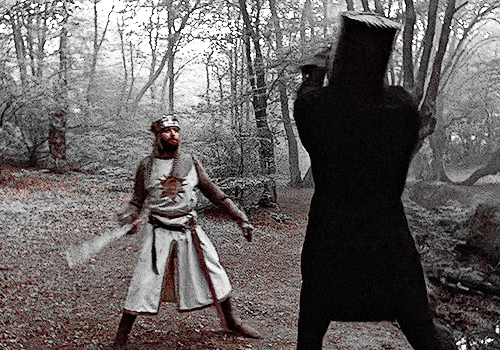





Monty Python and the Holy Grail (1975)
#monty python and the holy grail#monty python#the black knight#king arthur pendragon#john cleese#graham chapman#live action#dailyflicks#filmdaily#filmedit#movieedit#cinematv#dailytvfilmgifs#filmgifs#moviegifs#gif#gifset#some of the jokes in this were a tad repetitive for my taste but god. the black knight has a place in my heart
6K notes
·
View notes
Text

"I don't wanna talk to you no more, you empty headed cat bowl wiper! I fart in your general direction! Your mother was a hamster and your father smelt of elderberries!"

#monty python and the holy grail#monty python#french knight#taunter#cat cosplay#cosplay#cats#kitty#cats in costumes#cat#cats of tumblr#aww#cat costume#fan art#cat armor#english#humor#funny#movie
4K notes
·
View notes
Text
For all its dumbfuckery, Monty Python and the Holy Grail is genuinely the closest a film adaptation of the Arthurian mythos has ever gotten to capturing how deeply weird the source material really is.
5K notes
·
View notes
Text

Henry Jawson
1K notes
·
View notes
Text
Danny has an aggressive secret admirer and that Admirer is Damian wayne.
How this all started was during the Gotham exchange program where Danny had accidentally enrolled in as a joke but didn't think he actually get picked.
Luckily his rogues decided to give him some peace for once since they didn't want to go anywhere near Gotham because she a scary lady, but she actually a very misunderstood lady who just want companion..
Just have a odd way of expressing.. but she allow him in her city until the program is over but has hinted very cryptic if he want to stay then Her Knights have ways.
On his first day of gotham high, everyone so far kept whispered about the new wayne bait?
He didn't really listen but he was mostly asleep in the classes because he already have the whole class homework down already and he using this entire program as a vacation to sleep for once since he first became a halfa.
How he met Damian was pure accident.. literally, as he had accidentally body flipped him so hard to the ground due to Damian grabbing his shoulder and he really didn't meant it but his body instinctly grab his hand.
Which lead to his now peaceful vacation becoming a bit problematic.. as Damian will not leave him alone..
Unknownly to danny. He had gained admirer..
His locker filled with letters that would make Dora blush with how old fashioned they were written in. The occasion and daily weapon gift giving left in his own dorm.( he thought it was skulker leaving him weapons to try out on their next fight) The chocolates he kept receiving thought it was from the other girls from the other class room. Some of his clothes were missing but he thought it was his roommate.
Meanwhile Damian is at his wits end to the point of nearly putting cameras in Danny's room if it weren't for Tim catching on rather quickly on his 'too far gone deep obsession' with the new kid. He had been benched several times because he had been caught on several occasions trying to sneak into Danny's apartment, his locker, his gym locker. To the point they now trying to distract him from approaching danny.
He is just doing the courting rituals that he had learned so far from Talia.. he didn't even get to try the kidnapped and held hostage ritual yet :(
#damian wayne x danny fenton#damian is attractive to danny#danny's core is like the holy grail of danger#and damian is like the stabby moth going toward the light#danny is obvious but very flattered#batfam tried to stop damian from stalking danny#obviously didn't work but at least they tried#danny the ghost king#danny is obvious to the intention flirting and gift giving#damian a sneaky little stalker#dp x dc crossover#dc x dp#dead serious
3K notes
·
View notes
Text




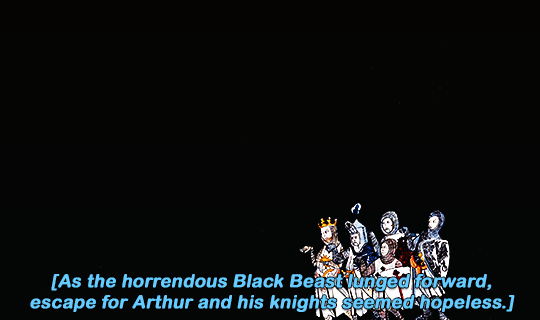


MONTY PYTHON AND THE HOLY GRAIL
1975 | dirs. Terry Gilliam, Terry Jones
#monty python and the holy grail#montypythonedit#filmedit#animationedit#terry gilliam#terry jones#1970s#my edit
2K notes
·
View notes
Text
The idea that Merlin enacts divine providence in setting Arthur on the throne is underlined by an emphasis on the observation of Christian ritual, often added by Malory. Thus Uther swears on the four Gospels (I.2, 8), the child is christened by ‘an holy man’ (I.3–5, 11), and Uther’s death is placed as God’s will. In promising that Uther will authorise Arthur to take the throne, Merlin associates himself with God, ‘God and I shalle make hym to speke’ (I.3–5, 11), and later assures the Archbishop of Canterbury that Jesus will ‘shewe somme myracle’ at Christmas (I.3–5, 12).
The episode of the sword in the stone thus seems divinely authorised, miracle rather than magic, and Arthur’s right is proven once again at the feast days of Candlemas and Pentecost. The light that shines like thirty torches from Excalibur (I.9, 19) functions as the king-light does in Havelok, and the later gift of the sword from the Lady of the Lake affirms the idea of Arthur as approved king. Again, the episode is carefully orchestrated by Merlin, who also advises of the protective virtue of the scabbard.
– Corinne Saunders, Magic and the Supernatural in Medieval English Romance
6 notes
·
View notes
Text
everybody moved on i’m still here

#armandaniel save me... save me armandaniel#s2ep5 holy grail of episodes methinks#although the pilot is still my favorite episode of all this is a CLOSE second#daniel molly gay4drugs and also kinda just gay in general you will always be famous!!!#interview with the vampire#armand#daniel molloy#armandaniel#devil's minion#armand iwtv#iwtv#iwtv amc
977 notes
·
View notes
Text


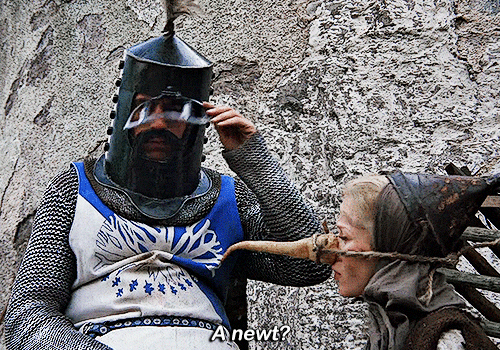
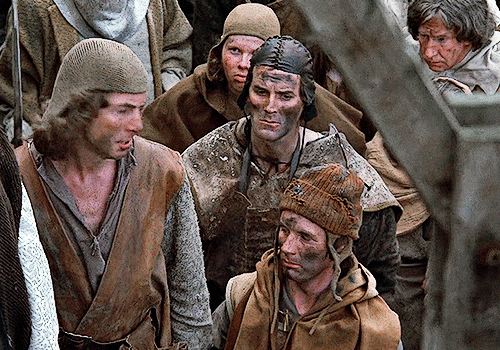

Monty Python and the Holy Grail (1975)
#monty python and the holy grail#monty python#live action#dailyflicks#filmdaily#filmedit#movieedit#cinematv#dailytvfilmgifs#filmgifs#moviegifs#gif#gifset
2K notes
·
View notes